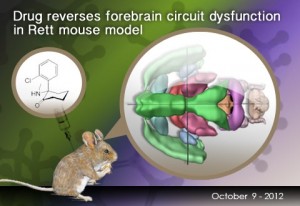Check out other stories from the Latest News
Drug Corrects Brain Circuitry in Rett Syndrome Mice
By Ishita Das on October 10, 2012

Background: Rett syndrome (RTT) is characterized by severe cardiac and respiratory impairments, together with autistic symptoms. It is believed that the brainstem and spinal cord functions controlling heart rate and breathing are compromised partly by an underactive set of brain structures, known as the limbic system, which are responsible for maintaining an appropriate emotional state. An increased understanding of the neural circuitry that governs behavioral and emotional states is therefore needed.
What’s new: Treating an adult mouse model of RTT with the FDA approved drug ketamine can reverse sensorimotor functions typical of RTT as well as remedy an altered gene expression pattern in the mutant mice, according to a breakthrough study appearing online, 3 October 2012, in the Journal of Neuroscience. Ketamine is a known inhibitor of NMDA receptors, which reduce excitation of neural circuits. Treatment with ketamine likely restores function by balancing neurotransmission.
Why it’s important: RTT occurs with an incidence of 1 in 10,000 females, in which 26% of deaths are sudden and of unknown cause. Cardiac arrhythmias and respiratory failure are considered to be at least partially responsible in some of these fatalities. Ketamine emerges as a strong candidate drug to improve physiological and neural functioning in RTT with important treatment implications for autism, which is rooted in imbalanced neurotransmission.
Help me understand :
| Source(s) : |
| Tweet |

